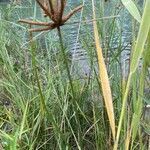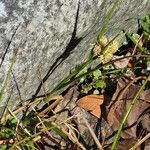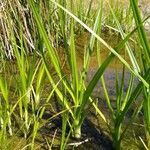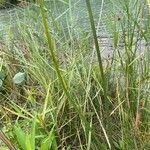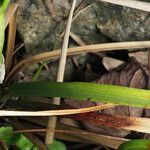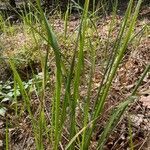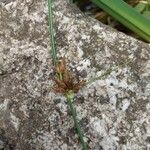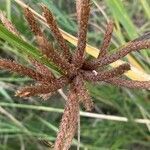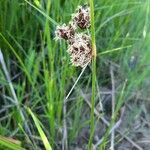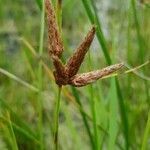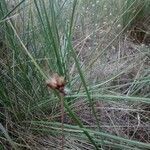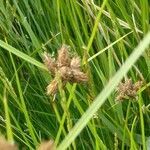Rhizomes creeping, terminated by a small ovoid tuber. Culms 25-50[-150] cm tall, 3-angled, smooth. Leaf sheath fronts with veinless triangular to rhombic area at summit; leaf blade linear, 2-6[-12] mm wide, flat, ± stiff, apical ones longer than or as long as culm. Involucral bracts 2 or 3, leaflike, overtopping inflorescence. Inflorescences of 1-10 spikelets, capitate [rarely with short rays]. Spikelets ovoid to narrowly ovoid, 10-16 × 3.5-7 mm, many flowered. Glumes bright orangish brown to stramineous, oblong-ovate, 5-8 mm, membranous, abaxially ± pubescent, 1-veined costa excurrent into a 1-3 mm awn, apex 2-cleft. Perianth bristles 6, ca. 1/2 as long as nutlet, retrorsely scabrous, usually not persistent on nutlet. Stamens 3; anthers linear-oblong, 2-4 mm; connective apex conic, ca. 0.5 mm. Style slender; stigmas 2, ± as long as style. Nutlet dark brown, broadly obovoid, ca. 2.5 mm, biconvex [compressed 3-sided], shiny, apex rounded to truncate. Fl. and fr. Jun-Sep. 2n = 64, 104, 112.
Perennial herb, 0.45-1.75 m high, rhizomatous, shoot bases bulbously thickened. Leaf blade 0.3-0.7 mm wide, flat, keeled, margins serrated. Culm nodose, sharply 3-angled. Inflorescence a head of 1-20 sessile or subsessile spikelets. Subtending bracts erect; blades leaf-like. Spikelets ovate, 15-20 x 7 mm. Glumes ovate, 7.5 x 4 mm, keel excurrent into awn up to 2 mm long. Perianth of (0-)3-6 retrorsely scabrid bristles. Style branches 3. Flowering time (Oct.) Dec.-Apr. Nutlet obovate, 3.0-3.4 x 1.9-2.4 mm, ± biconvex to ± 3-angled, shining dark brown, surface finely reticulate.
Rhizomatous perennial, up to 1.5 m tall. Leaf blades flat, keeled, margins serrated. Stems 3-angled, bases swollen. Inflorescence a terminal digitate head of (1-)few spikelets, occasionally stalked clusters added, basal bracts erect, leaf-like. Spikelets ovoid, 15-20 x 7 mm, glumes golden-to dark brown, awned.
Perennial herb, up to 1.2 m high. Stems sharply triangular. Leaves flat, midrib distinct, strongly keeled below. Inflorescence a compound anthela with clusters of spikelets on very unequal branches. Perianth segments of 6 retrorsely scabrid bristles, frequently of unequal size.
A herb or sedge. It has underground stems or rhizomes. It keeps growing from year to year. There is a small round tuber at the end of the rhizomes. The stalks are 25-50 cm tall and they are 3 angled. The leaves are narrow and 2-6 mm wide.
Robust or slender perennial to 1.2 m. Spikelets golden to dark brown.
